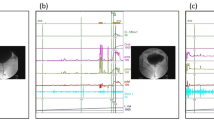Abstract
Twenty women diagnosed with functional urinary incoordination were randomly assigned to one of two treatment groups: biofeedback or progressive muscle relaxation. Ten subjects who were placed on a waiting list prior to treatment allocation served as a comparison group. The biofeedback intervention focused specifically on retraining of pelvic floor musculature (PFM). Patients were assessed pretreatment, posttreatment, and at 2-month follow-up. Outcome measures included self-reported symptomatology, psychological functioning, psychophysiological assessment of the PFM, and urologist ratings of problem severity and treatment efficacy. Both treatment approaches proved effective in improving symptomatology and psychological state. Subjects on the waiting list demonstrated no change in urological difficulties. No differences were found between the two treatment groups on any of the outcome measures. Theoretical and practical implications of the results are discussed.
Similar content being viewed by others
References
Abrams, P., Fenely, R., and Torrens, M. (1983).Urodynamics, Springer-Verlag, New York.
Allen, T. D., and Bright, T. C. (1978). Urodynamic patterns in children with dysfunctional voiding problems.J. Urol. 119: 247–249.
Barbalias, B. A., and Meares, E. M. (1984). Female urethral syndrome: Clinical and urodynamic perspectives.Urology 23(2): 208–212.
Beck, A. T., Ward, C. H., Mendelsohn, M., Mock, J., and Erbaugh, J. (1961). An inventory for measuring depression.Arch. Gen. Psychiat. 4: 561.
Bernstein, A., Philips, H. C., Fenster, H., and Linden, W. Psychological evaluation of female urethral syndrome—evidence for a muscular abnormality?J. Behav. Med. (in press).
Bernstein, D. A., and Borkovec, T. D. (1973).Progressive Relaxation Training: A Manual for Helping Professions, Research Press, Champaign, IL.
Church, R. M. (1964). Systematic effect of random error in yoked control design.Psychol. Bull. 62: 122–131.
Espie, C. A. (1985). Treatment of excessive urinary urgency and frequency by retention control training and desensitization: Three case studies.Behav. Res. Ther. 23: 205–210.
Hallam, R. S. (1976). A complex view of simple phobias. In Eysenck, H. J. (ed.),Case Studies of Behavior Therapy, Rutledge, London.
Kaplan, W. E., Firlit, C. F., and Schoenberg, H. W. (1980). The female urethral syndrome: External sphincter spasm as etiology.J. Urol. 124: 48–49.
Kazdin, A. E. (1980).Research Design in Clinical Psychology, Harper & Row, New York.
Kimmel, H. D., and Kimmel, E. (1970). An instrumental conditioning method for the treatment of enuresis.J. Behav. Ther. Exp. Psychiat. 1: 121–123.
Libo, L. M., Arnold, G. E., Woodside, J. R., Borden, T. A., and Hardy, T. L. (1983). EMG biofeedback for functional bladder-sphincter dyssynergia: A case study.Biofeed. Self-Regul. 8(20): 243–253.
Meizels, M., King, L. R., and Firlit, C. F. (1979). Urodynamic biofeedback: A new approach to treat vesicle-sphincter dyssynergia.J. Urol. 122: 205–209.
Malzack, R. (1975). The McGill Pain Questionnaire: Major properties and scoring methods.Pain 1: 277–299.
Myers, H. K. (1982). Bio-behavioural treatment of excessive micturition.Biofeed. Self-Regul. 7: 467–477.
Philips, H. C. (1988).The Psychological Management of Chronic Pain, Springer, New York.
Philips, H. C. (1989). Thoughts provoked by pain.Behav. Res. Ther. 27(4): 469–473.
Philips, H. C., and Jahanshahi, M. (1986). The components of pain behavior report.Behav. Res. Ther. 24: 1147–125.
Rovetto, F. M. (1983). Treatment of excessive urinary frequency and urgency by desensitization and progressive retention training.J. Behav. Ther. Exp. Psychiat. 14: 155–159.
Spielberger, C. D., Gorsuch, R. L., and Lushene, R. E. (1970).State-Trait Anxiety Inventory: Test Manual for Form X, Consulting Psychologists Press, Palo Alto, CA.
Sugar, E. (1983). Bladder control through biofeedback.Am. J. Nurs. 1152–1154.
Tanagho, E. A., Miller, E. R., Lyon, R. P., and Fisher, R. (1971). Spastic striated external sphincter and urinary tract infection in girls.Br. J. Urol. 43: 69–82.
Turk, D. C., Meichenbaum, D., and Genest, M. (1983).Pain and Behavioural Medicine: A Cognitive Behavioural Perspective, Gilford Press, New York.
Wilder, J. (1950). The law of initial values.Psychosom. Med. 12: 392.
Zarkowska, E., and Philips, H. C. (1985). A pain behaviour questionnaire. Unpublished manuscript.
Author information
Authors and Affiliations
Rights and permissions
About this article
Cite this article
Philips, H.C., Fenster, H.N. & Samsom, D. An effective treatment for functional urinary incoordination. J Behav Med 15, 45–63 (1992). https://doi.org/10.1007/BF00848377
Accepted:
Issue Date:
DOI: https://doi.org/10.1007/BF00848377




